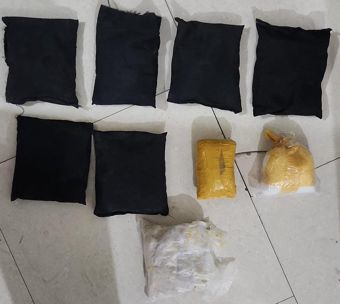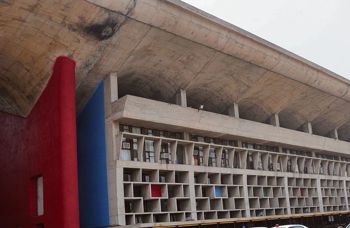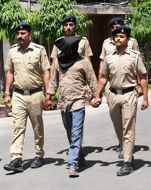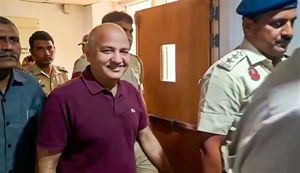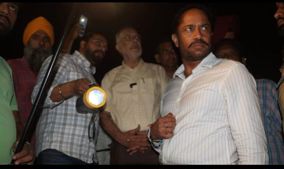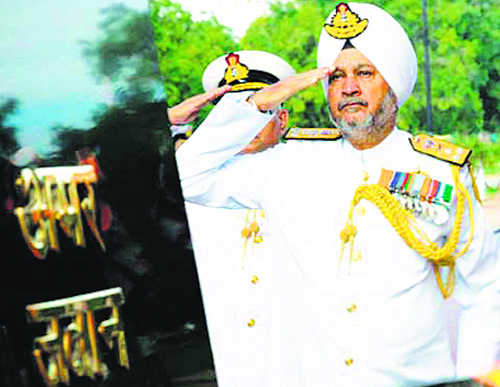
How has the Navy’s role changed in the past few years, especially after the 26/11 Mumbai attack?
Our information gathering after the 26/11 attacks has gone up manifold, and so have the response levels. Monitoring the sea is a 24x7 job on all 365 days of the year. We don’t wait for triggers, our mechanism is like a policeman on the beat. Our ships, planes and UAVs are on surveillance round the clock. In the last decade or so, the modus operandi at sea has changed. We need to secure the seas to help the economy flourish.
So many of the smaller fishing vessels lack the automatic identification system (AIS) that helps to pick out a friend or foe from among the thousands of vessels at sea.
Yes, sanitisation and identification are a challenge. We have a multi-layered surveillance system. We get information on fishing, about merchant activity and of air traffic. We monitor each and every ‘contact’ at sea. We do not interfere but monitor. Analysis of surveillance inputs is now real-time at the Information Management and Analysis Centre (IMAC) in Gurgaon and the joint operations centres of the Navy and the Coast Guard.
Doesn’t the recent incident off the coast of Porbandar when a small vessel from Pakistan was found carrying drugs bring into focus the threat of small boats?
Small boats were always a source of threat, we are gearing up and geared up to tackle it. Each ‘dot’ (on the radar) for us is a source of analysis. We do not let anybody pass. The nabbing of the Pakistani boat was a very good example of the synergy between Intelligence agencies and maritime agencies.
Has the installation of second phase of the coastal radars started after the 46 radars installed post 26/11?
Yes, it has started and is progressing very well to cover ‘blind spots’. In all, we will have 82 radars, including on the islands of Lakshwadeep and Andaman and Nicobar. We are almost there (to meet the target). Now we know the system of networking the radars; it is just about setting them up and is much easier than the first phase. Gujarat is the most sensitive location.
We have recently inaugurated INS Sardar Patel, a shore-based facility at Porbandar. It will be the hub for operations and surveillance.
After the 26/11 attacks, the Navy launched a mass contact programme with fishermen. What have been the results?
Fishermen are our eyes and ears. They have, in a way, become a part of the security set-up. Our fishing community is very alert after 26/11. At sea, they are the best people to analyse any outsiders in the waters. The boats have been ‘colour coded’ for each region and can be identified from a distance. It is a very well organised system.
China has offered $46 billion aid to Pakistan for the economic corridor connecting Gawadar port in the Arabian Sea with Xinjiang. China, in the past, has used merchant shipping for military purposes in South China Sea. How will things change for you in the Arabian Sea?
It’s not an issue. Our response mechanism is always in place. We have ships, aircraft radars and UAVs ready.
Have you factored in the People’s Liberation Army Navy (PLAN) ships coming regularly to Gawadar and the Arabian Sea?
Yes, certainly. A lot of energy requirement traverses through the North Arabian Sea, it’s very critical for the Gulf and also for Africa from where energy sources travel. Monitoring is our job.
Is China trying to control and monitor the Straits of Hormuz in the Persian Gulf? (India sources 62 per cent of its crude oil from the Middle East).
I don’t think that is an issue we have factored in. We do ‘crystal gazing’ and the Defence Minister’s operational directive that is based on national analysis is studied and force projection is based on that. Anybody can monitor the Hormuz, we are not concerned. Just like we are concerned about the security of the ocean, everybody else is also concerned.
In case of conflict, can somebody interdict our oil supplies from the Hormuz (Gawadar is between Hormuz and exit point of the Persian Gulf)?
Hormuz is a choke point that is a source of concern for everybody. It is not that only one country’s navy is patrolling there. Monitoring has intensified even more because of piracy and has navies of several countries.
Due to piracy, the sea lane of communication (SLOC) on our western sea front has moved closer to our coast. Isn’t there an inherent danger of so many ships of various cargo and sizes floating past?
That in a way speaks well of the security umbrella being provided by India in this region. These ships don’t affect us. We have are own operating procedures. Our job of surveillance has intensified. We have to keep an eye on the rogue ships. Wherever we have doubt, we board the ships. We really cannot shift the SLOC back, these are open waters in international waters and I don’t think it will happen in the foreseeable future.
What are these multi-layers of surveillance?
Besides the chain of coast-based radars, the AIS transponders have been set up on light houses, there is a long range ship recognition system. A Vessel and Air Traffic Management System (VTAMS) keeps the information updated. The response is again layered. A plane or helicopter could be sent to probe, a small ship can also be despatched while UAVs give live location of a ‘target’.
How is the progress of the ambitious project ‘Sea Bird’ at Karwar?
Things have settled down. We have shifted the repairs to Karwar and the base is up and running. It’s a good forward deployment base. We are getting dry docks and we will have a full-fledged dockyard.
Former Navy chief Admiral DK Joshi quit in February 2014. There was talk about lack of availability of submarine batteries?
Each sub has got a particular life cycle. It has to be operated for a fixed period and then will go for maintenance. Today, batteries are available. We have a set of Standard Operating Procedures (SOPs) in place.
By when will we have pilots fully trained for night landings on the seaborne aircraft carrier, the Vikramaditya?
We are doing the landings. It takes time for a pilot to qualify, he has to go through various stages. The warship is constantly tested to dominate an area of 500 square kilometres. We are very happy with the abilities of the warship.
At the last ‘Navy Commander conference’, there was a special mention of environment protection. Tourism hotspots like Goa have raised the issue of ‘tar balls’ washing up ashore.
The Navy has gone about it in a big way. We have started with the correct disposal on board ships. The harbour environment protection force does the patrolling and checking within our waters, that is 12 nautical miles from the coast. At mid-sea, it is international waters and we cannot hold anybody accountable. The Navy is working to reduce its carbon footprint.
The marine commandoes (Marcos) were sent in to challenge the terrorists during the 26/11 Mumbai attacks. Have you changed their outlook to close quarter battles?
The Marcos are a specialised and strong force. Their training levels are also set very high and they have their own strategy to tackle issues. A small team was in Yemen during the recent evacuations.





















